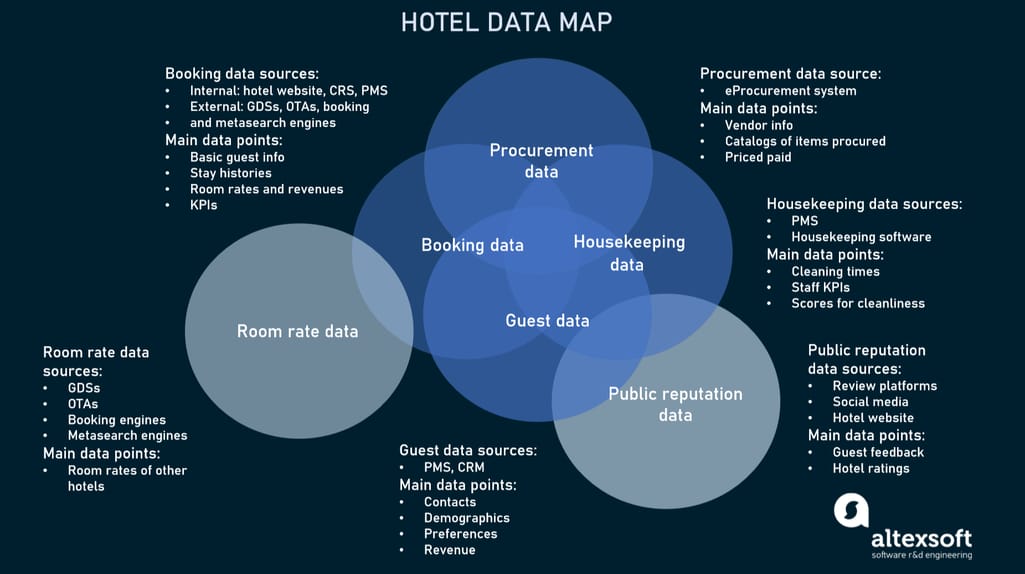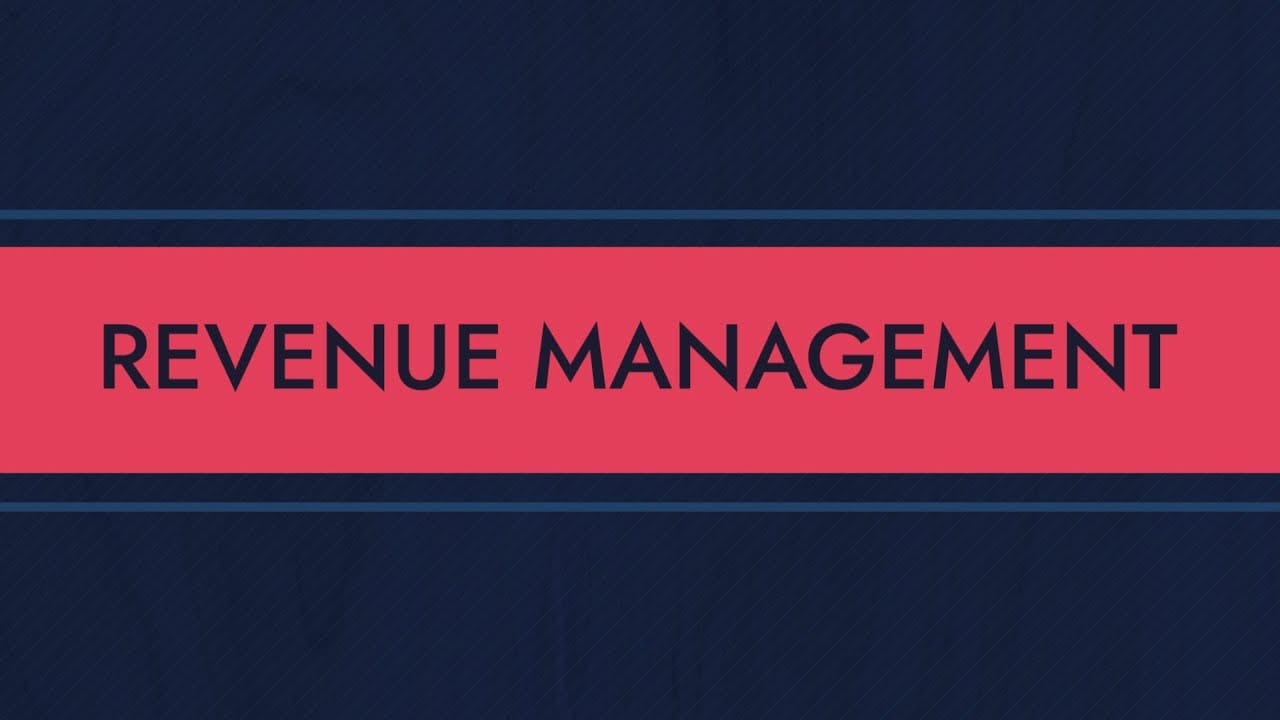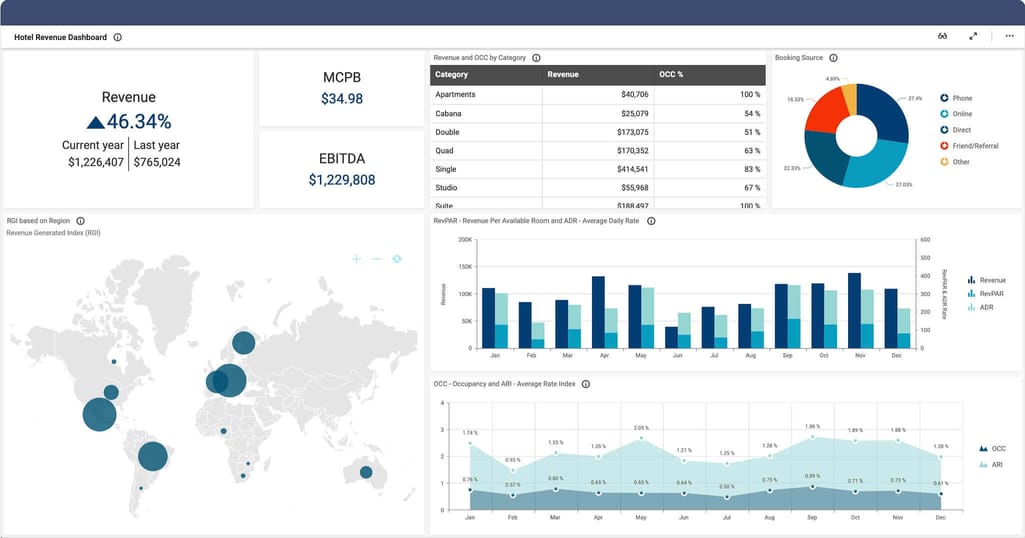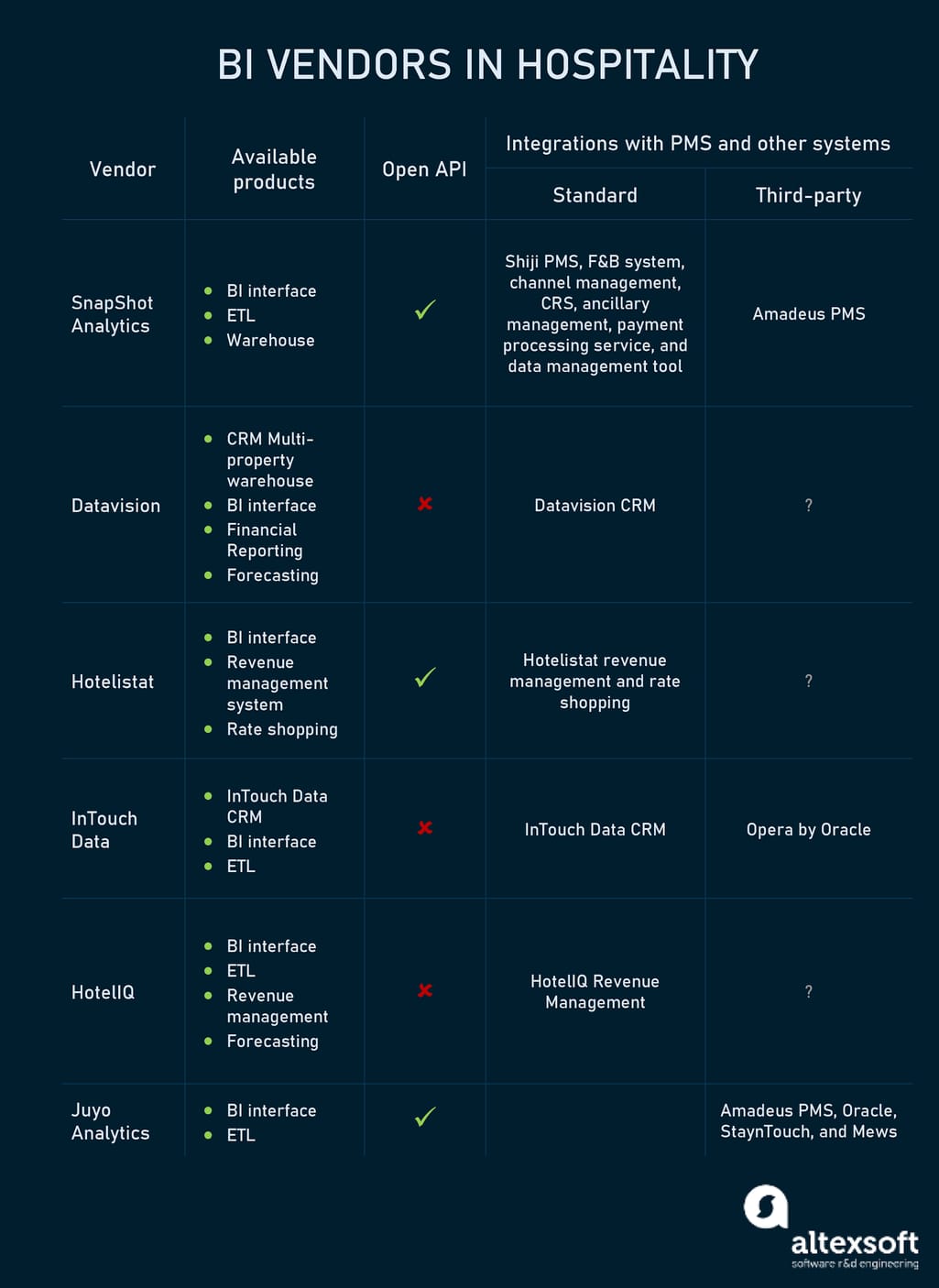Data analytics is one of the key directions for digital transformation in various industries, travel included. And hospitality is no exception: The hotel industry, by its nature, operates large amounts of data. The sources range from inventory to distribution channels, from customer behavior data to housekeeping records. As business grows, these become impossible to analyze and keep track of manually or by using spreadsheets.
Business intelligence (BI) exists to address the problem of capturing and understanding data. It’s a set of tools made for collecting data from multiple sources and transforming raw information into a meaningful form.
Today, we’ll look at the specifics of using BI in the hotel industry. We’ll define the peculiarities of business intelligence for hospitality, the benefits it gives to the businesses, and the pitfalls of integration with industry-specific systems. We’ll also have a look at the providers’ market for a clear view on the functionality offered.
Business intelligence in hotels: sources of data and components
Before we begin discussing the actual use cases of BI, let’s have a look at the key components of all BI systems and which data sources can be used across hotels.
Business intelligence systems take charge of extracting data from various sources, transforming it, collecting it in a centralized repository, and finally querying this repository to present data as meaningful charts and diagrams for humans to put to use.
Hotel data sources. A data source can be any internal/external system that contains valuable data about your business, metrics, customer information, etc. A Property Management System (PMS) and its modules like a Revenue Management System (RMS) or Central Reservation System (CRS), and channel management can be thought of as the main sources of data in hospitality.
Hotel Property Management System modules
On the diagram above you can see the structure of a PMS and its modules. Each of these modules can also serve as a source of data, whether it’s website analytics, a supply management system, or housekeeping.
If you look at the whole industry, various types of PMS structures can be found. Some hospitality businesses may need a separate module for yield management, some don’t, combining it with RMS. The number of components and data stored by the hotel determines the general data structure inside the organization. With the numerous spheres of activity in hotel business, data structures will also differ. In terms of BI, it presents challenges in determining the right data for analysis, but we’ll address this point further along.
Have a look at the hotel industry data map to get a general idea of the varied sources available.
Hospitality data types and its distribution across software systems
To learn more about hotel data management check our dedicated article.
Extract/Transform/Load or ETL tools. This component of a BI system is designed for automatic data transmission from one system to another. In the process, the data is cleansed, enriched with metadata, and structured to be understood by the system and its users.
Data warehouse/lake. Depending on the process and the amount of data, BI systems may require dedicated storage. Warehouse and data lakes are specific types of storages intended for working with large volumes of data.
BI user interface. Finally, all data is presented via user interfaces. These allow us to query data and visualize it. Mostly, BI would work with historical data to create visuals or reports. But in some cases, real-time data can also be processed, e.g. streamed data from IoT devices.
Business intelligence use cases for hotels
Given the abundance of available data sources and types of information, modern BI systems suggest a fairly holistic view of hotel activities and metrics. Let’s have a closer look at the main ones, but keep in mind that this list is nowhere near exhaustive.
Customer segmentation
Hospitality strives for an exclusive and unique approach to each individual customer. Guests can be segmented by demography, geography, behavior, etc. All of this data comes from bookings made on the website, purchases through POS systems, CRMs, or any other place where personal preferences are shown. As a practical use case, customer segmentation will help you consider personalized offers or tap into new opportunities in customer experience.
Reservation analysis
Occupancy rate is one of the main metrics for hospitality, which shows what percentage of units is occupied during the time period. Sourcing past occupancy rates from your PMS gives you an ability to analyze what factors affected it in the past and make forecasts for the future.
For example, you can compare annual data to analyze what impacts the occupancy, whether these are seasonal changes, events, changes in the competitor’s market, or your own pricing/marketing strategies. That way, you can figure out which tendencies are occurring regularly, and how you can respond to them to optimize your revenue.
Revenue management and advanced pricing strategies
Revenue management is a complex discipline that considers hundreds of factors to predict optimal pricing and generate target revenue. Revenue management operates several KPIs like average daily rate (ADR) or revenue per available room (RevPar), or total revenue per available room (TRevPar).


Revenue Management - the science of ultimate hotel success
One of the spheres of interest for revenue management is demand forecasting, which relies on hotel bookings and market data. By sourcing market data and utilizing historical information on your own reservations, it’s possible to consider all KPIs for analysis. If you’re opting for custom solutions, a number of advanced methods can be applied, including search engine data or other publicly available sources to make demand forecasts.
Down below you can see an example of a dashboard providing insights for revenue managers on marketing costs per booking (MCPB) and net revenue growth.
Revenue management analytical dashboard. Source: www.boldbi.com
With the advances of machine learning, business intelligence data can be applied to automate rate changes and introduce dynamic pricing.
Instead of analyzing this data manually, ML models can be trained on your historical data to spot tendencies and suggest optimal prices for a given period.
Distribution channel analysis
A single hotel may have hundreds of partnered distributors (OTAs, GDSs, bed banks, etc.) that connect via channel managers. To sell rooms via indirect channels, channel managers take into account the distribution cost of each channel (commission and taxes). BI can provide insights into the revenue generated by each channel, comparing it to distribution and other costs. So it is easier to understand which partnered distributors bring value to your business.
Additionally, if you’re bound by rate parity agreements, distribution channel analysis may help with identifying distributors that violate rate parity and contribute to revenue leakage. A number of suppliers — that we discuss below — suggest automatic rate disparity alerts about channels that break the status quo.
Competitor overview
Hotels operate in a highly competitive environment. So, understanding what your competitors propose to customers is crucial. There are a number of ways that hotels can access market data, like using data from market consolidators (STR, HotelMarketData, or HotelTechReport), or just scraping the prices of your direct competitors in the region. Either way, BI will present a competitive advantage for a hotel helping to optimize pricing/marketing strategies.
This is just a short list of problems that modern BI systems solve in hospitality. Unfortunately, there are barriers that impede adoption. Let’s talk about them.
What are the challenges of integrating business intelligence in the hotel industry?
Despite the benefits BI can bring to the hotel business, there are some challenges we need to address.
Determining the right data
As was mentioned above, hotels operate with lots of data sources, each storing different information in various formats. To integrate a data platform in your business, first you need to determine which data will be taken for analysis and what the purpose of this data is.
Business domain makes the task specific for the hotel industry: Multiple properties may have different infrastructure and types of data stored. So the choice of data sources will depend on the analytical purposes. This task is traditionally handled by a data science team that can analyze the information you have. But, the business side of a choice remains for the hotelier to decide.
Integration issues
BI as a technological concept represents several software tools that will be integrated into your internal infrastructure. The connection between the systems will allow BI to automatically extract required data from its source, apply transformation, and upload pieces of information to generate reports and visuals.
The integration between two software systems is established via an Application Programming Interface or API. This is a type of connector that enables software programs to exchange data and access each other's functionality. When it comes to hotel software, there are three categories of underlying systems:
- Legacy software or no software at all. This category includes hoteliers that either don’t use PMS and other hotel management software at all, or utilize legacy systems that are difficult to integrate using modern data transfer standards.
- PMS with closed API. Software shipped by PMS vendors may have a closed API specification. That means the API access isn’t so easily available for third parties — if it even exists. In this case, hoteliers have to either rely on their existing vendor’s tools (many PMS providers support at least some analytics) or consider other providers.
- PMS with open API. This opposite of the previous variant provides access to an API and the API documentation is available for other developers.
To integrate one software system with another, the API should have an open specification. In the case of a closed API, PMS vendors will be in charge of creating a custom integration with each required system. This presents several difficulties on its own in terms of accessibility and maintenance.
What does it mean for the hotel? In simple words, legacy PMSs (or no PMS at all) can’t be integrated with third-party software. Closed APIs will also present challenges, as you will need to contact the PMS provider to create a custom API connection, after which you will have to make adjustments once there is an update to your PMS.
The issue is well known across the industry, and there are some existing solutions:
Out of the box integration. Software and BI vendors specifically address the integration issue through development of out-of-the-box integrations with popular PMSs that either have close or open APIs.
- Impala API is a universal API that aims at connecting as many PMS systems as possible to be accessible via a single interface. The list of already available PMSs includes 6 systems: Oracle Hospitality Opera, Oracle Hospitality Suite8, Protel, Guestline, Clock PMS+, and Mews. Also, hoteliers can vote for desired PMSs to appear in Impala’s list of integrations.
- Custom PMSs are often used by large hotel networks, because of data security concerns or the absence of a system on the market that fits. This is an expensive investment. However, building a custom system will guarantee an ease of integration with any other software.
So, now we can discuss some of the prominent business intelligence providers that develop BI software specifically for the hotel industry. The following section will suggest some of the products available on the market and their specific features.
BI providers for hotel industry
The market of business intelligence can be divided by general purpose instruments and hotel analytics providers. For the most part, BI vendors offer a full range of services for building analytical systems in your hotel. But some focus on specific tasks like revenue management. Here, we’ll have a look at some of the most popular hospitality BI systems.
Most BI providers have rather similar feature sets. They include:
- Data integration and storing
- Dashboards
- Reports and forecasts
- Data visualization
- Revenue tracking
- Multi-property management

A comparison of hospitality BI providers
Snapshot Analytics
SnapShot Analytics is a hospitality BI provider that focuses on offering a full range of data platform components. These include data storing/transformation tools, and a BI interface itself. The product also supports custom visualizations as a feature of the analytical interface.
Partnering with Shiji Group, hospitality software provider, SnapShot offers the following six products and integrates with them out of the box:
- Cloud based and mobile PMS
- Infrasys Food & Beverage system
- Shiji distribution system (channel management/CRS)
- Ancillary management system
- Payment processing
- Data management tools
Among the popular systems, Snapshot is also integrated with Amadeus Property Management.
Datavision
Datavision is a BI and hospitality software vendor that connects multiple systems to gather and analyze data. The company is listed among the members of international hospitality technology companies like HTNG, AHLA, HSMAI, and HFTP. These organizations develop technological standards for the hospitality industry, so the membership proves the vendor is on par with the latest technology trends.
The range of analytical services includes 5 products:
Datavision CRM helps analyze reservation and guest information as historical data.
Multi-Property is a data collection and warehousing service. It allows you to connect different sources of data and store them in one place.
Datavision analytics is an analytical interface end-users can utilize to gain access to graphical interpretation of data, reporting, etc.
Financial reporting is a tool designed for daily reports on data gathered from multiple systems.
Forecasting is a service that uses your available data to provide forecasts based on historical information. You can upload Excel or Spreadsheets files to the Datavision database to share data within the organization and distribute forecasting features among different departments.
Hotelistat
Hotellistat also offers various services for hospitality, including data services and business intelligence. The business intelligence suite comes as a basic solution for data analysis that can be integrated with Hotellistat revenue management, and rate shopping systems. Additionally, Hotellistat offers web analytics, review, and social media management tools.
These integrations come out of the box, as Hotellistat is positioned as an all-in-one solution for hospitality businesses. The tools mentioned allow users to connect various systems under a single analytical interface, to source internal and external data for reports, visuals, and customization.
The pricing page specifies 3 types of plans with payments on a monthly basis:
- Smart plan: includes a command dashboard and price shopping for €99 which is approx. $116 per month. The plan also lists a custom integration with one PMS system.
- Clever plan: duplicates services from the previous plan, but adds on top BI analytics. The cost is €169 or approx. $199 per month.
- Intelligent plan: includes all the listed services. The cost is €249 or approx. $293 per month.
InTouch Data
InTouch Data offers 3 products that relate to data service and analytics:
PmsXtract is a tool made for extracting data from various property management systems. It is basically an ETL tool specifically for hotel software. Connecting the required sources will establish an automatic flow of data. The integration with PMSs is custom-made for each client, but there are also standard solutions like integration with Opera PMS.
HotelSnapShot is a business intelligence solution representing an end-user analytical interface. It offers a wide range of analytical features like ad-hoc reporting, customizable dashboards, drag-and-drop interface, and visualization. HotelSnapShot can be integrated with any required hotel systems including PMS, Rate Shopping, or POS.
DataArc is a CRM solution that is integrated with mentioned analytical solutions.
HotelIQ
HotelIQ offers a range of services for hospitality analytics. These include an interactive analytical dashboard, tools for data management and preparation, and predictive features. The whole analytical system is split by departments and hotel activity spheres. So here you will find interfaces designed for revenue managers, marketing analysts, sales teams, operations management, and customer data.
The pricing page specifies three types of plans that include different services, but the cost is calculated by inquiry.
Juyo Analytics
Juyo Analytics is a large hospitality data platform that offers integrations with various PMS providers like Amadeus, Mews, Oracle, and StayNTouch systems. The list of partnerships also mentions hotel market data consolidators and benchmark providers. All of these tools are integrated as a service to enrich data and get more precise analysis of market conditions.
The analytical interface is available as a customizable dashboard, providing insights from internal systems and external sources. Juyo Analytics has a predictive feature in-built, working on a machine learning algorithm, that takes the historical data to provide demand or budgeting forecasts.
In sum, the choice of a vendor depends on the range of services you are going to use, as well as the ease of integrations offered. We suggest you look towards hospitality specific BI providers, as they focus more on integrating hotel systems with their existing solutions. The calculation of the price offered is based on the computation power or as a tiered price per month/year.
Justifying investments in BI
Existing in a highly competitive environment, hotels fight for any opportunity to optimize their performance. The data on its own doesn’t necessarily make sense to the business, but rather the way the data can be used.
Business intelligence is a handy tool that reduces a lot of manual labor in terms of gathering all the nuggets of information. This gives us a broader view of what’s going on, so we can forecast many things, starting from our own expenses on supplies and electricity, to overviewing annual yields. And while it's a huge time-saver, BI also provides a competitive advantage, as more and more businesses shift to a data-driven approach to decision making.

